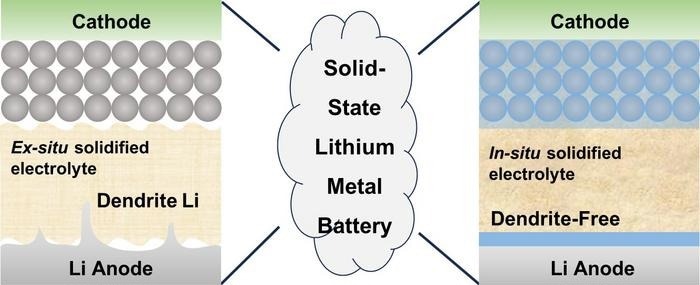A Recent review, spearheaded by Prof. Qiang Zhang and Prof. Chen-Zi Zhao from the Department of Chemical Engineering at Tsinghua University, highlights forthcoming opportunities aimed at advancing the practical applications of in-situ solidification in rechargeable lithium metal batteries.
 Solid-state lithium metal batteries with ex-situ solidification and in-situ solidification. Image Credit: ©Science China Press.
Solid-state lithium metal batteries with ex-situ solidification and in-situ solidification. Image Credit: ©Science China Press.
Currently, the energy density of commercial lithium-ion batteries has nearly reached its limit. Liquid lithium metal batteries (LMBs) are preferred for their high-energy-density (>500 Wh kg−1), but their commercialization faces challenges due to the flammability and explosiveness of the liquid solvent, as well as the growth of lithium dendrites.
Solid-state LMBs, with the solid-state electrolyte (SSE) at their core, offer advantages such as high-energy-density, wide operating temperature range, long cycling lifetime, and enhanced safety. Therefore, the practical strategy of substituting solid-state electrolytes for organic liquid electrolytes emerges as a viable approach to achieve high-performance and high-security LMBs.
The largest challenge facing the adoption of SSE is the inherent poor solid-solid contacts in solid-state LMBs, which results in huge electrochemical polarization and inferior performance. Especially, when matched with high-areal-loading cathode, how to preserve the conformal interfaces becomes more prominent due to the larger number of pores between the electrode particles.
Qiang Zhang, Professor, Department of Chemical Engineering, Tsinghua University
Addressing the aforementioned challenge, the evolving in-situ solidification technique can establish superior conformal contacts at the electrode/electrolyte interfaces. It creates swift ion transport pathways between the electrode/electrolyte and electrode particle/particle, resulting in reduced interfacial impedance and enhanced electrochemical performance. Significantly, solid-state LMBs utilizing the advancing in-situ solidification technology demonstrate considerable development potential.
This review centers on the safety aspects of high-energy-density LMBs as a starting point. It elaborates on the significance of in-situ solidification in enhancing safety and adaptability, tracing the developmental history of in-situ solidification.
The synthesis techniques of in-situ solidified polymer electrolytes are emphatically introduced. Practical applications of in-situ solidification technology are advocated through artificial interphase construction and polymer electrolyte design, elucidating the pivotal role of in-situ solidification technology in advancing high-performance and high-safety LMBs.
Finally, the design, challenges, and application prospects of in-situ solidified polymer electrolytes are presented to catalyze advancements in current energy technologies.
Journal Reference:
Xu, P., et al. (2023). A review of solid-state lithium metal batteries through in-situ solidification. Science China Chemistry. doi.org/10.1007/s11426-023-1866-y.